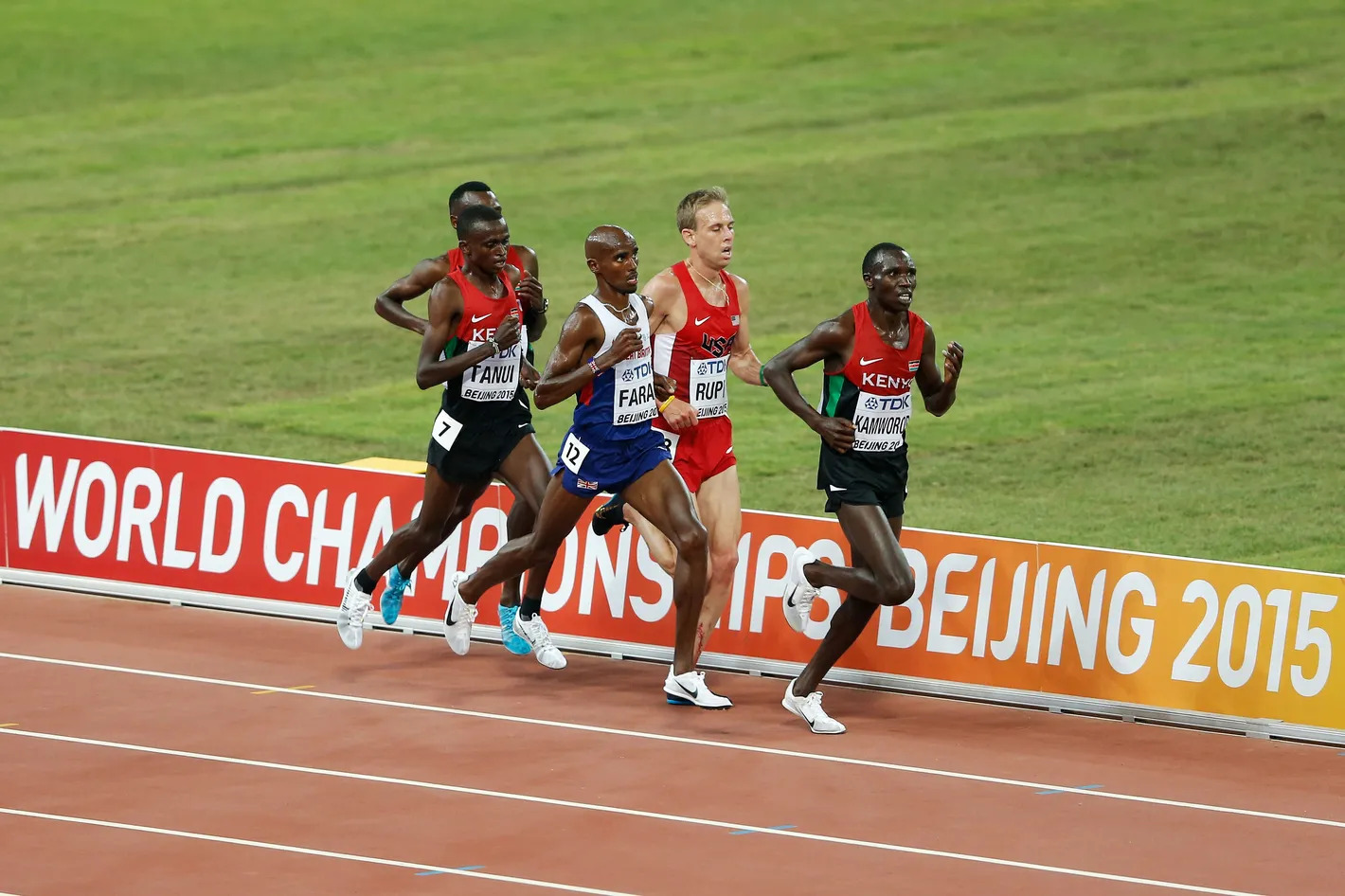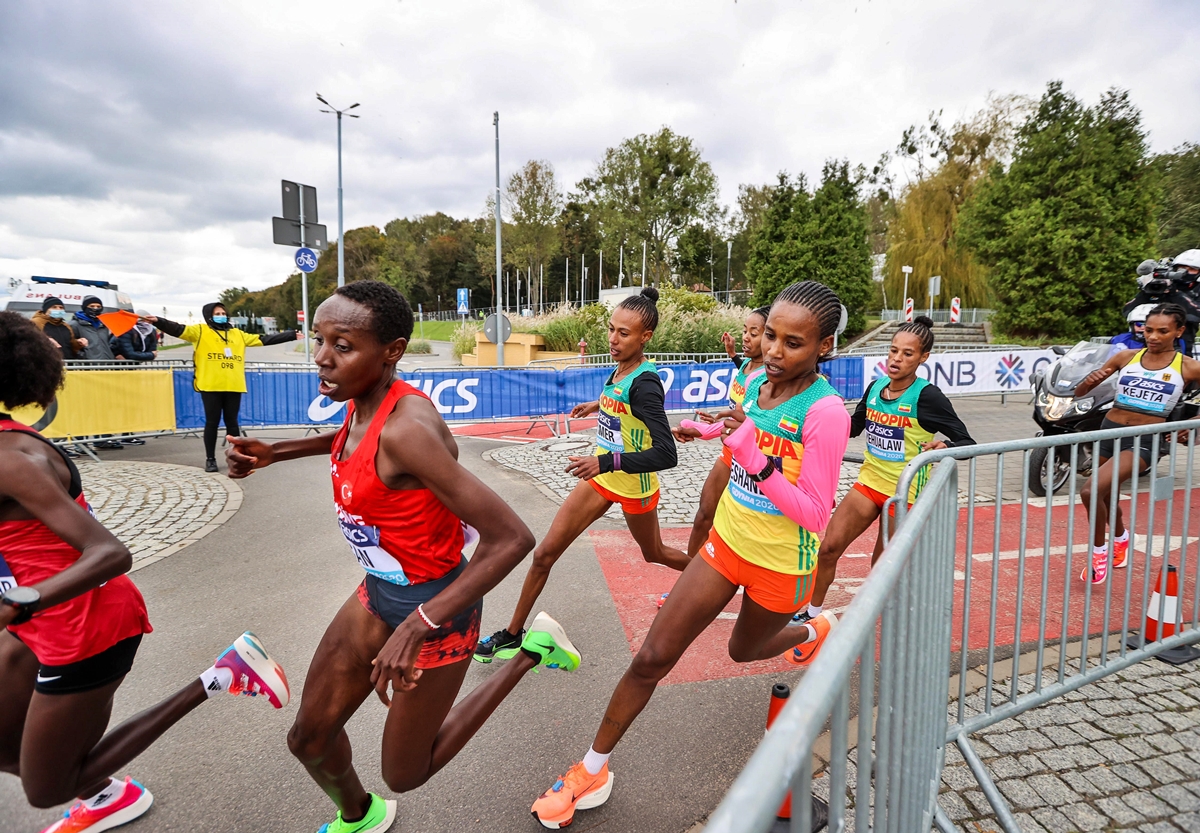

Featured
What Is Considered Long Distance Running
Modified: August 21, 2023
Discover the benefits and challenges of long distance running. Get expert tips and advice from our featured athletes. Boost your endurance and achieve your running goals today!
Introduction
Welcome to the world of long distance running! Whether you are a seasoned runner or just starting out, long distance running is an invigorating and challenging pursuit that offers a multitude of benefits for both the mind and body. In this article, we will take an in-depth look at what exactly constitutes long distance running, discuss the health benefits it offers, delve into the training required, explore common injuries associated with the sport, and provide valuable tips to help you make the most of your long distance running journey.
Long distance running, also known as endurance running, refers to any running event that spans a distance of 5 kilometers (3.1 miles) or more. It requires a combination of physical stamina, mental fortitude, and disciplined training. Unlike shorter distance sprints, long distance running is a test of endurance where athletes strive to maintain a consistent pace over extended periods of time.
One of the key benefits of long distance running is the positive impact it has on cardiovascular health. Regular participation in this form of exercise helps to strengthen the heart and improve its efficiency in pumping blood. This, in turn, increases the oxygen supply to the muscles, enabling them to perform more efficiently. Additionally, long distance running helps to lower blood pressure, reduce cholesterol levels, and decrease the risk of heart disease.
Beyond the physical benefits, long distance running also plays a vital role in improving mental well-being. Engaging in this challenging activity releases endorphins, which are natural mood enhancers that promote feelings of happiness, euphoria, and a sense of accomplishment. In addition, the solitude and rhythm of running provide an opportunity for mental clarity and stress relief, making it an ideal activity for those seeking an escape from the demands of daily life.
Are you ready to embark on a long distance running journey? Before you lace up your running shoes, it is essential to follow a well-structured training plan. Building endurance gradually is key to preventing injuries and ensuring long-term success. We will explore training strategies in more detail in the next section.
As with any physical activity, there is a potential for injury in long distance running. Overuse injuries, such as runner’s knee, shin splints, and stress fractures, are common among runners. It is important to be aware of the signs of these injuries and take necessary precautions to prevent them. We will discuss common injuries associated with long distance running and ways to mitigate them later in this article.
To help you make the most of your long distance running journey, we have compiled a list of valuable tips and advice. From proper warm-up techniques to choosing the right shoes and maintaining a balanced diet, implementing these tips can enhance your performance and enjoyment of the sport.
Now that you have a better understanding of what long distance running entails and the benefits it offers, let’s dive into the training strategies required to excel in this endurance sport. Remember, success in long distance running is a marathon, not a sprint!
Definition of Long Distance Running
Long distance running, also known as endurance running, is a form of aerobic exercise that involves running for extended periods over distances of 5 kilometers (3.1 miles) or more. Unlike shorter distance sprints that focus on explosive speed, long distance running emphasizes endurance, stamina, and the ability to maintain a steady pace over a prolonged period of time.
This sport has a rich history that dates back to ancient times. In ancient civilizations, long distance running was often used as a means of communication, delivering messages between cities and kingdoms. It was also a competitive sport in events such as the Olympic Games in ancient Greece. Today, long distance running encompasses a wide range of organized races, from 5K and 10K races to marathons and ultramarathons that span distances of 50 kilometers or more.
The popularity of long distance running has surged in recent years, with people of all ages and fitness levels embracing this challenging yet rewarding activity. Participating in a long distance run not only provides a sense of accomplishment but also offers numerous health benefits for both the mind and body.
While the specific distance that qualifies as long distance running may vary depending on individual perspectives, the general consensus is that any race or training run that exceeds 5 kilometers can be classified as long distance. This distinction is significant because the training methods and physiological demands of long distance running differ from those of shorter distance running.
In long distance running, pacing is crucial. Runners aim to maintain a consistent pace throughout the entire distance, distributing their energy effectively to avoid burnout. This requires a combination of cardiovascular fitness, muscular endurance, and mental resilience. Endurance training, which involves gradually increasing the distance and duration of runs over time, is a fundamental aspect of preparing for long distance races.
Long distance running also presents unique challenges in terms of hydration, nutrition, and mental focus. Adequate hydration is essential to prevent dehydration, especially during longer races where fluid intake is critical. Proper nutrition plays a vital role in fueling the body before, during, and after runs, ensuring that runners have the necessary energy to sustain their performance. Additionally, maintaining a positive mental attitude and employing mental strategies, such as visualization and positive self-talk, can help runners overcome fatigue and push through mental barriers.
Long distance running is a highly inclusive sport that welcomes individuals of all backgrounds and abilities. Whether you are a seasoned runner looking to challenge your limits or a beginner seeking to improve your fitness and health, long distance running offers an exciting and fulfilling journey.
Health Benefits of Long Distance Running
Engaging in long distance running provides a multitude of health benefits for both the body and mind. From cardiovascular improvements to mental well-being, here are some of the key advantages to incorporating long distance running into your fitness routine:
1. Cardiovascular Health: Long distance running is an excellent way to strengthen your heart and improve cardiovascular fitness. As you run, your heart works harder to pump oxygenated blood to your muscles, which helps to enhance its efficiency. Over time, this can lead to a lower resting heart rate, improved blood flow, and reduced risk of heart disease.
2. Increased Endurance: Long distance running is a sport that focuses on building endurance. Regular training gradually improves your ability to sustain physical activity for longer periods, allowing you to run farther distances without feeling fatigued. This increase in endurance can also translate into improvements in other areas of life, such as increased stamina for everyday activities.
3. Weight Management: Long distance running is an effective way to burn calories and contribute to weight loss or maintenance. As a high-intensity aerobic exercise, running boosts your metabolism and helps you burn calories long after your run is over. Combining regular long distance running with a balanced diet can lead to healthy and sustainable weight management.
4. Mental Well-being: Running releases endorphins, often referred to as the “feel-good” hormones, which can elevate your mood and combat stress. Long distance running offers a form of meditation and solitude, allowing you to clear your mind and find a sense of calmness. It can also provide a great sense of achievement and boost your self-confidence and self-esteem.
5. Bone Health: Weight-bearing exercises like long distance running help to strengthen bones and reduce the risk of osteoporosis. The impact of running stimulates bone formation, making them denser and less prone to fractures. It is important to ensure proper form and wear appropriate footwear to minimize the risk of stress fractures or other running-related injuries.
6. Improved Lung Function: Running requires deep breathing, which helps to expand and strengthen the lungs. Over time, this can enhance lung capacity and oxygen uptake, leading to improved respiratory function. In turn, increased lung efficiency allows the body to deliver more oxygen to the muscles, facilitating better endurance and performance.
7. Reduced Risk of Chronic Diseases: Regular participation in long distance running has been associated with a decreased risk of chronic diseases such as type 2 diabetes, certain types of cancer, and high blood pressure. The combination of cardiovascular exercise, weight management, and improved overall health contributes to a lowered risk of these conditions.
It is important to note that obtaining these health benefits requires consistency and proper training. Start gradually and progressively increase your running distance and intensity to avoid overexertion and prevent injuries. Remember to listen to your body, fuel it with a balanced diet, and incorporate rest days into your running routine for optimal recovery.
By engaging in long distance running, you can not only improve your physical health but also enhance your mental well-being, ultimately leading to a more balanced and fulfilled life.
Training for Long Distance Running
Training is a vital component of long distance running and plays a crucial role in improving your endurance, speed, and overall performance. Whether you are a beginner or an experienced runner, following a well-structured training plan is essential. Here are some key considerations when it comes to training for long distance running:
1. Gradual Progression: It is important to start with a training plan that matches your current fitness level and gradually increase the distance and intensity of your runs. This gradual progression allows your body to adapt and build strength, reducing the risk of injuries. Aim to increase your weekly mileage by no more than 10% to avoid overexertion.
2. Build Endurance: Long distance running requires a high level of endurance. Incorporate at least one long run into your weekly training schedule, gradually increasing the distance over time. During these runs, focus on maintaining a steady pace rather than sprinting. Running at a pace that allows for conversation is a good indicator of an appropriate endurance-building effort.
3. Interval Training: Interval training involves alternating between periods of high-intensity running and recovery periods. This type of training helps to improve your speed, endurance, and lung capacity. Incorporate interval workouts into your training plan by running at a faster pace for a predetermined distance or time, followed by a recovery period.
4. Strength Training: Strengthening your muscles is crucial for long distance running. Incorporate strength training exercises such as squats, lunges, and core exercises into your routine to improve your overall running performance. Focus on building strength in your legs, core, and upper body to maintain proper form and reduce the risk of injuries.
5. Cross-Training: Cross-training activities, such as cycling, swimming, or yoga, can complement your running training and provide a break from repetitive impact. These activities help to improve cardiovascular fitness, flexibility, and strengthen muscles that are not typically used in running. It is important to choose cross-training activities that are low-impact and do not negatively impact your running performance.
6. Rest and Recovery: Rest and recovery days are just as important as training days. Your body needs time to repair and rebuild after intense training sessions. Incorporate rest days into your training plan to prevent overtraining and reduce the risk of injuries. During rest days, engage in active recovery activities such as gentle stretching, foam rolling, or walking to promote blood flow and aid in muscle recovery.
7. Listen to Your Body: Pay attention to any signs of fatigue, pain, or discomfort during your training. Pushing through severe pain or neglecting injuries can worsen the condition and lead to long-term setbacks. If you experience persistent pain or injuries, seek professional advice from a healthcare provider or a sports medicine specialist.
Remember that every runner is unique, and what works for one person may not work for another. It is essential to listen to your body, make adjustments to your training plan as needed, and set realistic goals that align with your abilities and lifestyle. Consistency and patience are key in long distance running training, as progress takes time. Celebrate each milestone and enjoy the journey towards reaching your long distance running goals.
Common Injuries Associated with Long Distance Running
Long distance running offers numerous health benefits, but like any physical activity, it carries the risk of certain injuries. Understanding and recognizing these common injuries can help you take preventive measures and seek appropriate treatment when necessary. Here are some of the most common injuries associated with long distance running:
1. Runner’s Knee: Also known as patellofemoral pain syndrome, runner’s knee is characterized by pain around the kneecap. The repetitive impact and constant bending and straightening of the knee during running can cause irritation and inflammation. Factors such as weak quadriceps muscles, improper footwear, and running on uneven surfaces can contribute to this condition.
2. Shin Splints: Shin splints are characterized by pain along the shinbone (tibia). It occurs when the muscles and tendons surrounding the shinbone become inflamed or strained. Shin splints can result from overuse, improper running form, running on hard surfaces, or wearing worn-out shoes.
3. Stress Fractures: Stress fractures are tiny cracks in the bones caused by repetitive stress, particularly in the weight-bearing bones of the foot and lower leg. They often develop gradually and cause localized pain. Factors contributing to stress fractures include sudden increases in mileage, inadequate rest and recovery, improper footwear, and poor bone density.
4. Plantar Fasciitis: Plantar fasciitis is the inflammation of the plantar fascia, a ligament that runs along the bottom of the foot. Runners with plantar fasciitis experience pain and stiffness in the heel or arch of the foot, particularly in the morning or after periods of inactivity. This injury can be caused by overpronation, improper footwear, excessive mileage, or tight calf muscles.
5. Achilles Tendinitis: Achilles tendinitis is characterized by inflammation of the Achilles tendon, located at the back of the ankle. It typically causes pain and stiffness, especially during physical activity. Overuse, inadequate stretching, sudden increases in training intensity, and improper footwear can contribute to this condition.
6. IT Band Syndrome: The iliotibial (IT) band is a long band of connective tissue that runs along the outside of the thigh. IT band syndrome occurs when the band becomes inflamed and causes pain on the outside of the knee. Factors such as overpronation, weak hip muscles, running on banked surfaces, or sudden increases in training volume can contribute to this injury.
7. Blisters and Chafing: While not necessarily as serious as other injuries, blisters and chafing are common occurrences in long distance running. Friction caused by repetitive motion and moisture can lead to painful blisters or skin irritation. Wearing moisture-wicking socks, properly fitting shoes, and utilizing appropriate lubricants can help prevent these issues.
To minimize the risk of these injuries, it is important to follow a few preventive measures. Gradually increase your mileage, allowing your body to adapt to the demands of running. Invest in good-quality, properly fitted running shoes that provide adequate support and cushioning. Incorporate strength and flexibility exercises into your training regimen to build stability and prevent muscle imbalances. Listen to your body and take rest days when needed, allowing for proper recovery. In the event of an injury, seeking medical advice from a healthcare professional specialized in sports medicine is crucial for proper diagnosis and treatment.
By being aware of these common injuries and taking the necessary precautions, you can continue to enjoy the countless benefits of long distance running while minimizing the risk of setbacks and maximizing your running experience.
Tips for Long Distance Running
Long distance running is a challenging and rewarding pursuit. To help you make the most of your running journey, we have compiled a list of valuable tips and advice to enhance your performance, prevent injuries, and ensure an enjoyable experience:
1. Follow a Proper Training Plan: Stick to a structured training plan that gradually increases your mileage and incorporates rest days. Consistency is key to building endurance and avoiding overuse injuries.
2. Warm-Up and Cool Down: Prior to each run, warm up with dynamic stretches or light jogging to increase blood flow to your muscles. After your run, cool down with static stretches to improve flexibility and promote recovery.
3. Choose the Right Shoes: Invest in a pair of high-quality running shoes that provide proper support and cushioning. Consult with a professional at a specialty running store to ensure you have the right shoes for your foot type and running style.
4. Focus on Good Running Form: Maintain an upright posture, relaxed shoulders, and quick turnover of your feet. Avoid overstriding and excessive heel striking to prevent injuries and improve efficiency.
5. Stay Hydrated: Proper hydration is essential for long distance running. Drink water before, during, and after your runs to maintain optimal fluid levels. Listen to your body’s thirst signals and adjust your water intake accordingly.
6. Fuel Your Body: Consume a balanced diet that includes a mix of carbohydrates, proteins, and healthy fats to provide the necessary energy for long distance running. Experiment with different pre-run fueling strategies to find what works best for you.
7. Incorporate Strength Training: Include strength exercises in your training routine to build muscular strength and prevent imbalances. Focus on core exercises, leg exercises, and exercises targeting the hips and glutes to support proper running mechanics.
8. Listen to Your Body: Pay attention to any signs of pain, discomfort, or fatigue during your runs. Rest when needed and seek medical attention if pain persists or if you suspect an injury.
9. Gradually Increase Mileage: Avoid sudden increases in mileage, as this can increase the risk of overuse injuries. Gradually build up your distance to allow your body to adapt and recover effectively.
10. Enjoy the Journey: Long distance running is not just about the finish line; it’s about the experience along the way. Embrace the process, set realistic goals, and celebrate milestones. Remember, every step you take brings you closer to achieving your running aspirations.
Incorporating these tips into your long distance running routine can help enhance your performance, minimize the risk of injuries, and create a more enjoyable and fulfilling running experience. Remember to listen to your body, seek guidance from professionals when needed, and most importantly, have fun on your running journey!
Conclusion
Long distance running is a challenging yet fulfilling pursuit that offers a host of physical and mental benefits. By understanding the definition of long distance running, appreciating its health advantages, following proper training techniques, being aware of common injuries, and implementing valuable tips, you can maximize your running experience.
Long distance running not only strengthens your cardiovascular system, increases endurance, and aids in weight management but also contributes to improved mental well-being, bone health, and lung function. By participating in this sport, you join a community of individuals who share a passion for pushing their limits and achieving personal goals.
To ensure your success as a long distance runner, it is important to follow a well-structured training plan. Gradual progression, endurance building, interval training, strength training, and proper rest and recovery are all key components. Listening to your body and seeking professional advice if needed will help you avoid common running injuries and setbacks.
Remember, long distance running is not just about the physical aspect; it’s also about enjoying the journey. Find joy in the process, celebrate your accomplishments along the way, and cherish the sense of achievement that comes from crossing the finish line. Whether you are an experienced runner or just starting out, long distance running has something to offer everyone.
So lace up your running shoes, embark on this exciting adventure, and experience the countless benefits that long distance running has to offer. Embrace the challenges, push your boundaries, and discover the incredible strength and resilience within you. With dedication, perseverance, and the right mindset, you can become a successful long distance runner and enjoy a healthier and more fulfilling life.









